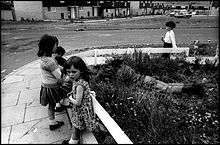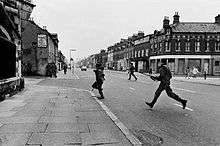Battle of Lenadoon
The Battle of Lenadoon was a series of gun fights over six days from the 9–14 July 1972[1] between the Provisional IRA and the British Army, having started on Thursday, 9 July 1972 in and around the Lenadoon Avenue area and spreading to other places in Belfast. Loyalist paramilitaries and the Official Irish Republican Army were involved in some of the incidents. 28 people in total were killed in Belfast according to the CAIN: Sutton Index of Deaths. The violence ended a two-week truce between the forces of the British Government and the IRA.[2]
| Lenadoon Avenue Battle | ||||||||
|---|---|---|---|---|---|---|---|---|
| Part of The Troubles | ||||||||
| ||||||||
| Belligerents | ||||||||
|
|
|
Ulster Defence Association | ||||||
| Commanders and leaders | ||||||||
|
Lieutenant Robert Williams-Wynn |
| Sammy Murphy | ||||||
| Units involved | ||||||||
|
| |||||||
| Strength | ||||||||
| 600+ soldiers |
100+ paramilitaries
| unknown | ||||||
| Casualties and losses | ||||||||
|
8 killed 30 wounded |
Provisional IRA: | At least 1 UDA member killed, unknown injured | ||||||
| 14 civilians killed | ||||||||
 Where the battle started | ||||||||
Background
In 1972 The Troubles had been ongoing in Northern Ireland for three years,[3][4] with Irish Republican paramilitaries increasingly attacking the Royal Ulster Constabulary and the British Army, and a level of societal violence had appeared that had not seen in island of Ireland since the 1920s during the Irish Civil War. Shootings, bombings and riots had become a daily theme of life in Northern Ireland,[5] and from August 1971 gun battles between Irish Republican paramilitaries, the British Army and Loyalist paramilitaries were a regular occurrence in Belfast, especially in its West and North districts, with their concentrations of rival populations.
After "Bloody Sunday", when the British Army shot dead fourteen unarmed civil rights marchers, Irish Republican paramilitarism gained substantial support, and recruits flooded in to join the IRA both the Provisional (PIRA) & Official (OIRA) wings. By the spring of 1972 the IRA believed they were winning and were using the slogan "Victory 72".[6] In June 1972 the IRA's Army Council called a ceasefire to accommodate talks between an IRA delegation and the British Government. The truce lasted two weeks, with hardline IRA members eager resume revolutionary violence believing they had the upper hand against the British Government in the deteriorating law and order situation in Northern Ireland, and victory was in their sight.[6]
9 July
Two days after secret talks between the British Government and IRA leadership in London broke down, the IRA in the West Belfast became involved in a sectarian confrontation in the Lenadoon Estate where there was an attempt by a large group of Catholics to move families into 16 empty council houses in Lenadoon Avenue that had been abandoned by Protestants, who had fled their homes due to the recent sectarian rioting, the Catholic families had themselves been forced to flee from other parts of the city. In an attempt to prevent a riot between the Catholics and the Protestant population that resided in the South of the Lenadoon Estate which had support from the UDA, a British Army detachment blocked the road with its armoured vehicles to halt the crowds advance, which then deteriorated into a riot when the Army rammed a moving truck to prevent it crossing the barricade. That evening the IRA in Belfast announced an end to its ceasefire, saying that the act was in response to events at Lenadoon Estate, and IRA Army Council member Seamus Twomey, who had been negotiating with the British Army in the district up until that point, ordered Brendan Hughes who was in command of an IRA unit in the vicinity to open fire on the British Army, and gun battles broke out.[7]
Riots and other violence occurred in other areas in Belfast that night. In what became known as the "Springhill Massacre" British Army snipers shot dead three Catholic civilians, a Volunteer of the Official IRA and a 16 year old member of Na Fianna Eireann (the IRA's youth wing), and injured two others civilians. Elsewhere in Belfast two Protestant civilians Brian McMillan (21) & Alan Meehan (18) along with an off-duty Catholic member of the British Army Joseph Flemming (30) were found shot dead in a semi burnt out car in Little Distillery Street just off the Grosvenor Road; it's believed Republican paramilitaries were responsible for these killings, possibly in retaliation to the events at Springhill, but no one acknowledged responsibility for the murders. A third Protestant civilian was found shot dead near the waterworks of Cavehill Road, also killed by Irish Republican paramilitary elements. In Belfast a 60 year old Catholic civilian was shot dead by the British Army while driving his car near the Falls Road, and the IRA shot dead a Ulster Defence Association member (Gerald Turkington, aged 32) in the Markets Area of Belfast. In total eleven people were killed on the 9 July in Belfast.

10 July
More gun battles and rioting took place the following day although nobody else was killed. William Whitelaw admitted secret talks had taken place between the IRA and British government.[8][9]
11 July
The IRA attempted to blow up a British Army observation post in Lenadoon Avenue, using a mechanical digger loaded with a massive bomb in its bucket. A Volunteer drove the machine into the billet and his comrades surrounded the billet and fired thousands of shots to cover him but the bomb failed to explode properly.[10][11] Between 2:30 pm – 3:00 pm a 16 year old Volunteer from the OIRA's Youth Wing Gerard Gibson was shot dead by the British Army in Carrigart Avenue, Suffolk,Belfast near Lenadoon.[12] A Catholic civilian Charles Watson (21), was found shot dead off Carlisle Circus, it's believed the UDA was behind the killing. Also a Volunteer of the Official IRA's youth wing Gerard Gibson (16) was shot dead by the British Army.

14 July
Six hundred additional British troops were sent into Lenadoon Avenue to confront the IRA as the IRA had taken over most of the estate at this stage in the battle, this resulted in an exchange of fire which resulted in the deaths of a further six people. A PIRA sniper shot dead a British soldier in command of an armoured car unit, Robert Williams-Wynn (24) in Lenadoon Avenue, the armoured unit was trying to isolate IRA volunteers in the area, a 64 year old Protestant civilian was shot dead during a PIRA sniper attack on a British Army base in Highfield, Belfast, and Louis Scullion (27) a PIRA gunman was shot dead by the British Army at the Unity Flats in Belfast. William Whitelaw speaking in the House of Commons said that the IRA had used a rocket launcher in one of the exchanges of fire and that they had six of them in their inventory to date.[10][13]

Another exchange of gunfire took place in the Ardoyne district during the battle, with an Official IRA Belfast Brigade gunman, Edward Brady (30),[14] being shot dead by the British Army, and two British soldiers were shot dead by gunmen from the Provisional IRA Belfast Brigade.[15] Although the British Army claimed Edward Brady was an IRA member, and the Official IRA at the time claimed him as one of their members, his family in later years denied he was involved with any paramilitary group.[16][17]
Aftermath
The IRA continued to intensify their campaign of bombing, sniping and ambushes. Just one week after the end of the battles around Belfast, the Provisional IRA carried out one of its largest bombing operations ever. In what became known as Bloody Friday, they planted and exploded 22 car bombs in Belfast City in the space of 75 minutes, killing 9 people which included civilians, members of the security forces and a UDA member while also seriously injuring approximately 130 others.
References
- https://www.youtube.com/watch?v=pd6KZ8EnMHU&t=570s
- Alan F. Parkinson - 1972 And The Ulster Troubles p.183 - 185, p.189 - 191
- http://cain.ulst.ac.uk/othelem/chron/ch69.htm#12869
- http://cain.ulst.ac.uk/othelem/chron/ch69.htm#Aug
- http://cain.ulst.ac.uk/events/intern/intern.htm
- Peter Taylor - Behind The Mask: The IRA & Sinn Fein p.160,161
- 'The Battle of Lenadoon Estate', 20 July 1972, Thames Television broadcast. Published on Youtube 27 March 2019. https://www.youtube.com/watch?v=pd6KZ8EnMHU
- http://cain.ulst.ac.uk/proni/1972/proni_CAB-9-G-27-6-3_1972-07-10.pdf
- Melaugh, Dr Martin. "CAIN: Chronology of the Conflict 1972". Retrieved 3 February 2017.
- "U.K.: FIVE DEAD AFTER BELFAST'S BIGGEST GUN BATTLE OF THE YEAR". Archived from the original on 19 July 2011.
- "AN PHOBLACHT/REPUBLICAN NEWS".
- http://relativesforjustice.com/wp-content/uploads/2018/11/Gerard-Gibson-Rep-AUG-2018.pdf
- "10 Killed in Ulster; I. R. A. Fires Rockets (July 15, 1972)". Retrieved 3 February 2017.
- https://issuu.com/glenravel/docs/troubles15/93
- https://cain.ulster.ac.uk/sutton/chron/1972.html
- http://storiesfromsilence.com/edward-brady/
- http://www.irishnews.com/news/northernirelandnews/2017/01/11/news/family-of-man-shot-dead-in-1972-say-police-reports-clear-his-name-878112/